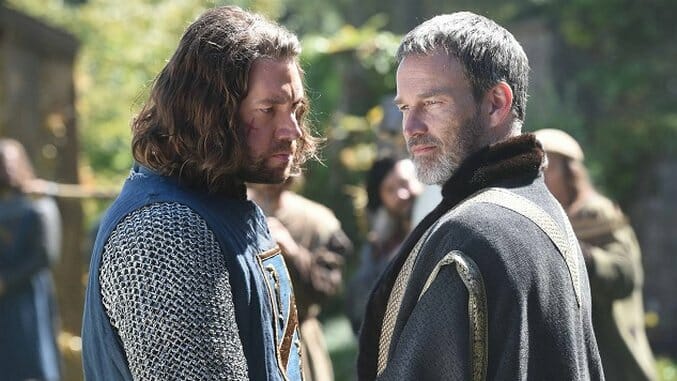The Bastard Executioner: “A Hunger/Newyn”
(Episode 1.04)

After a two-part pilot and a pair of standalone episodes, The Bastard Executioner has become a show that’s fully worth watching. We’re too far past the point at which Kurt Sutter’s Welsh medieval torture baby could ever be called “perfect,” but where he’s contented himself playing solo rounds of speedball since the series’ premiere, he finally has the chessboard out in “A Hunger/Newyn.” Maybe he’s been playing chess all along, though, moving pieces from square to bloody square in service of seeing his overarching goal—whatever it is—realized. If so, Sutter is the most glacially-minded chessmaster in the history of the game, but at least the direction of The Bastard Executioner’s split narrative has started taking shape.
“A Hunger/Newyn” (pronounced “ne-ween”) starts out with a handful of disparate images—two men on the run from English guards and Annora doing cryptic things as Annora does, among others—before settling into a multi-arc groove. Baroness Lowry is on her way to Windsor to meet with King Edward II and hash out the future of Ventrishire in a post-Ventris world; Corbett, in her absence, hatches a plot to develop Ventrishire into a place of economic and military power, courtesy of nefarious collusion with visiting Baron Pryce (Richard Brake); Wilkin continues to adapt to his new role as punisher; and Annora’s witchery is further explored both in her cavern residence and in the dungeons of Windsor, where Tobias, the surviving man from the pre-credits opener, finds himself left at the mercy of Ed Sheeran.
If you were on tenterhooks to find out who the singer/songwriter would portray on The Bastard Execution—by all standards a show that has little need for someone of Sheeran’s precious disposition—well, now we know. He’s a punisher, just like Wilkin, except that he cuts a far more sinister figure. Maybe we don’t expect Sheeran to direct the mutilation of another human being. Maybe it’s his pale, ginger visage. Maybe it’s the fact that Windsor’s jail, decorated with the flayed skin of former prisoners (“seraphim,” apparently, according to Tobias’ hosts), naturally add a few degrees of evil to anybody creeping around in their depths. And, of course, since it’s 14th century England, the man running Windsor’s old school enhanced interrogation department happens to be an archdeacon. Surprise!
-

-

-

-

-

-

-

-

-

-

-

-

-

-

-

-

-

-

-

-

-

-

-

-

-

-

-

-

-

-

-

-

-

-

-

-

-

-

-

-








































